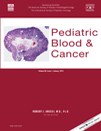Extraneural ependymoma: Distant bone, lung, liver, and lymph node metastases following bevacizumab†
Conflict of interest: Nothing to report.
Abstract
Extraneural metastases of ependymoma are rare, and have been reported in the lungs, lymph nodes, pleura, mediastinum, liver, diaphragmatic muscle, and bone. We report a case of anaplastic ependymoma with distant metastases to the vertebral bones, lungs, liver, and lymph nodes following treatment with bevacizumab. Recent research has hypothesized that angiogenic tumors may develop means of resistance to antiangiogenic therapies, and some evidence suggests potential for antiangiogenic therapies to promote additional means for cancer spread. Nevertheless, antiangiogenic therapies continue to demonstrate potential as potent therapies for the treatment of many cancers, and should continue to be researched for future uses. Pediatr Blood Cancer 2013; 60: 143–145. © 2012 Wiley Periodicals, Inc.




